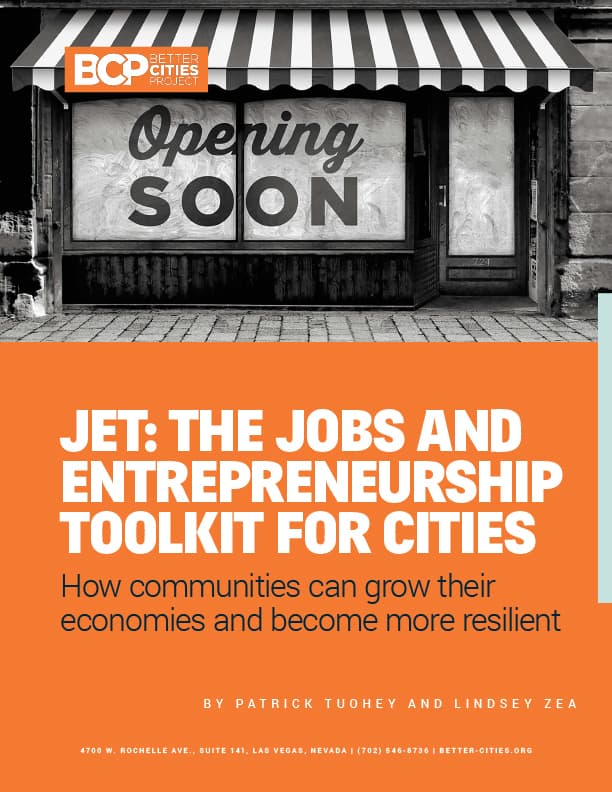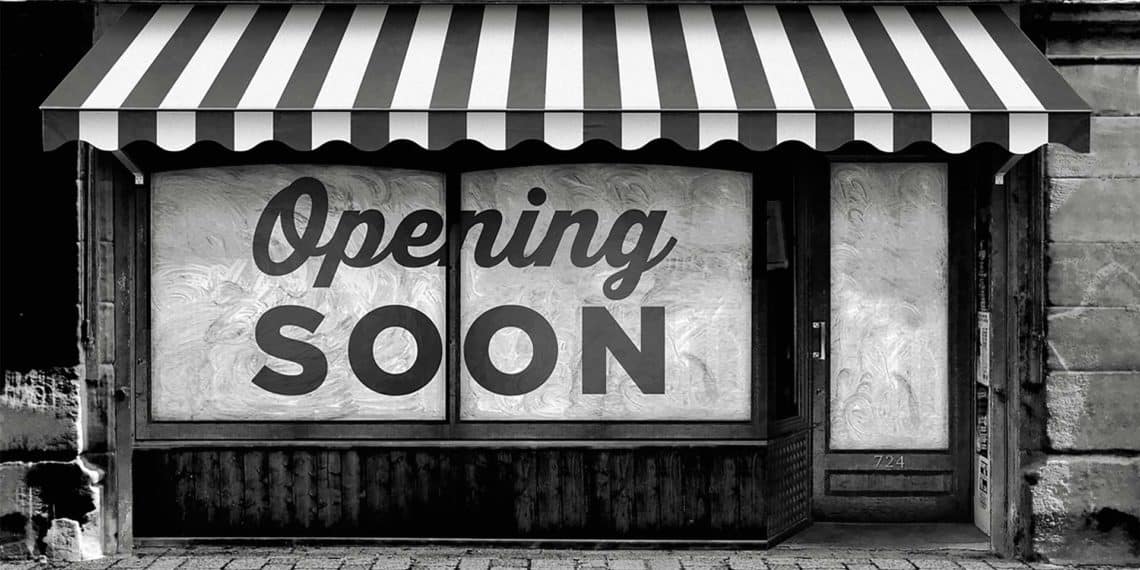Across America, from our largest cities to small towns in the heartland, local leaders are trying to figure out the best way to grow.

There’s a lot at stake: A vibrant local economy has resiliency during hard times, more jobs for residents and a growing tax base. That’s not the total definition of success, but for tens of millions of people, it’s a solid foundation.
So it’s unsurprising city leaders pay close attention to rankings that compare them with other communities. But although these rankings are important, they don’t tell the whole story.
Much of what goes into city success is out of local leaders’ hands. And cities that do rank highly often have complex or unresponsive processes for starting a business. They are, literally, successful in spite of themselves.
So what’s a city – and what are city leaders – to do?
Encouraging local entrepreneurs and businesses promises greater return than expensive incentives for far-away and mature firms. This toolkit helps municipal policymakers straighten the path forward for entrepreneurs so they can create economic growth. The ideas may not seem as bold as luring large employers with taxpayer-funded goodies, but they are more likely to create an environment in which a city’s own employers can thrive.
Leaders should spend less time trying to cut deals with Walmart, and more time encouraging the next home-grown Sam Walton. This toolkit can help.
Control — and the lack thereof
What things make a city attractive for business? Which things can city leaders readily affect? And which have borne fruit elsewhere? Identifying those policies correlated with high performance is our goal with the Jobs and Entrepreneurship Toolkit (JET).
First, let’s set aside things that might make a city attractive, but over which local policymakers have little or no control – like climate and geography. They are compelling and help sell a city to would-be residents, but there is little hope city councils can brighten the skies or raise snow-capped mountains.
There are things that may appear within reach of policy, but require several steps and many players at many levels of government. These might include the population density of the existing city, the employers and industries that already happen to be there or the capital investment available to start-ups. Policies that seek to bolster those characteristics may be worthwhile — there is certainly a lot written about how to affect change through these factors — but they are prey to many moving parts and are long-term programs.
Then there is just happenstance. A city might simply be home to an individual or group doggedly determined to overcome all the obstacles before them. In a 2012 interview on NPR, economist and author Enrico Moretti was interviewed about his book, The New Geography of Jobs. When asked about how cities might replicate “innovative job clusters,” he offered an answer that might be unsettling to policymakers:
It’s very tough, because if you look historically where the innovation clusters are located, almost none of them [were] created by some deliberate, explicit policy. It’s really hard to engineer an innovation cluster. We talk about Seattle, but if you look at a lot of the clusters, they were all born in very random, often serendipitous, ways. So it’s really hard for policymakers to engineer from scratch.
Increasing the chances for city success
JET looks at short- and near-term policies that cities can adopt to encourage individuals and businesses to do what they do best: grow and improve.
Allowing for all the other things beyond cities’ control, city leaders aren’t powerless in creating a successful entrepreneurial environment. Even in cities like Orlando, blessed with a beautiful climate and good state-level policy, there is room for improvement. Local governments can increase the chances of success in their cities by straightening paths and removing obstacles to the real work of innovation that will be carried out by the entrepreneurs themselves.
A city’s time and energy is best spent encouraging homegrown entrepreneurs and innovators to invest in themselves and their ideas. It will always be tempting to use economic development incentives to lure large successful employers away from other locations, but those successes are few and far between, if they exist at all. Instead, cities should bet on the men and women already calling their community home to accelerate economic growth and spur job creation.
4 rankings, 4 very different pictures of city success
BCP looked at four reports rating US cities on their business friendliness in order to determine which policies contributed to high ratings for business friendliness. These included WalletHub’s 2019 “Best Places to Start A Business,” the Surge City Index, Arizona State University’s Doing Business North America (DBNA) and the US Metropolitan Area Economic Freedom Index (MEFI).
WalletHub “Best Places to Start A Business”
WalletHub, a credit monitoring and improvement service, published its “Best Places to Start A Business” study in May 2019. They considered, “19 key metrics, ranging from five-year business-survival rate to office-space affordability.” Not all of that is the purview for local policymakers, so for this effort BCP only considered the rankings for Business Environment, which included items such as average growth in number of small businesses, start-ups per capita and job growth (2017 v 2013).
Austin-Round Rock-Georgetown, TX
Salt Lake City, UT
Raleigh-Cary, NC
Nashville-Davidson–Murfreesboro–Franklin, TN
San Francisco-Oakland-Berkeley, CA
San Jose-Sunnyvale-Santa Clara, CA
San Diego-Chula Vista-Carlsbad, CA
Denver-Aurora-Lakewood, CO
Orlando-Kissimmee-Sanford, FL
Portland-Vancouver-Hillsboro, OR-WA
Phoenix-Mesa-Chandler, AZ
Seattle-Tacoma-Bellevue, WA
Miami-Fort Lauderdale-Pompano Beach, FL
The Surge Cities Index
The Surge Cities Index, published by Inc. Magazine in December 2019, was developed in partnership with the Startup Genome. It examines metropolitan statistical areas (MSAs) as opposed to city limits, and so includes multiple counties surrounding a given city. The Surge study looked at several indicators; given that all were relevant to business, we included overall scores in this analysis.
Both the WalletHub and Surge ratings offer valuable ways to measure a local economy, but not the underlying policies. Nevertheless, they likely either affect the decisions of everyday entrepreneurs and investors who do drive the local economy or they measure the actions of market players.
Austin-Round Rock-Georgetown, TX
Salt Lake City, UT
Raleigh-Cary, NC
Nashville-Davidson–Murfreesboro–Franklin, TN
San Francisco-Oakland-Berkeley, CA
San Jose-Sunnyvale-Santa Clara, CA
San Diego-Chula Vista-Carlsbad, CA
Denver-Aurora-Lakewood, CO
Orlando-Kissimmee-Sanford, FL
Portland-Vancouver-Hillsboro, OR-WA
Phoenix-Mesa-Chandler, AZ
Seattle-Tacoma-Bellevue, WA
Miami-Fort Lauderdale-Pompano Beach, FL
Doing Business In North America
For rankings of how public policy affects entrepreneurship, BCP considered Arizona State University’s Doing Business North America (DBNA) 2020 evaluation methodology for Starting a Business. This used three indicators including number of procedures for starting a business, time in days, and cost as a percentage of income per capita. The DBNA score is important — it is the only study that measured in some form the impact of local policy. DBNA has minimum-population thresholds and a cap of four cities per state, so cities that appear in other indices and may have ranked well in DBNA could have been excluded.
Arlington, VA
Denver, CO
Jackson, MS
Colorado Springs, CO
Kansas City, MO
Aurora, CO
St. Louis, MO
Virginia, Beach, VA
Billings, MT
Cheyenne, WY
Indianapolis, IN
Minneapolis, MN
Sious Falls, SD
US Metropolitan Area Economic Freedom Index
BCP also relied on the US Metropolitan Area Economic Freedom Index (MEFI), which was published in 2019 and examined government spending, taxation and labor market freedom as defined by minimum wage, private union density and government employment as a percentage of total state employment. It also examined MSA rather than discrete city boundaries. While those measures seem least focused on business creation, the report makes a compelling argument that population growth and personal income correlate with previous economic freedom index scores.
Houston-The Woodlands, TX
Jacksonville, FL
Tampa-St. Petersburg, FL
Richmond, VA
Dallas – Fort Worth, TX
Nashville-Davidson, TN
Miami-Fort Lauderdale, FL
Austin-Round Rock, TX
Orlando-Kissimmee, FL
San Antonio-New Braunfels, TX
Washington-Arlington
Oklahoma City, OK
Virginia Beach, VA
But rankings don’t tell the whole story
While each rating system was internally consistent, taken together they underscore the complexity of good local economic policymaking.
Many factors contribute to a good entrepreneurial environment. Consider, for example, Miami, Florida and Austin, Texas:
Both cities appeared in the top 15 US cities in three of the four rating systems BCP considered.
Both have robust business climates and so scored well on both WalletHub’s Business Environment ranking and the Surge Cities overall index.
Their respective states’ lack of an income tax helped them do well on the US Metropolitan Area Economic Freedom Index, as many cities from Florida and Texas also appear high on that list.
But the DBNA ranking for Starting a Business — which counted the time and money required for filing paperwork to open a business — ranked Miami and Austin 33rd and 42nd respectively.
A crucial point: Cities can have flourishing business environments for lots of reasons other than their own policies. This has important ramifications for state policymakers, whose efforts can help local economies, as well as for city and county officials, who can benefit from greater clarity in prioritizing their efforts. A high ranking doesn’t mean your work is done, and a low ranking doesn’t mean your city is powerless to improve.
As a result of this realization, this toolkit is focused on presenting the municipal programs and policies that show promise in encouraging start-ups and entrepreneurs to grow their enterprises.





One entrepreneur's story
Orlando resident Kelly-Anna Salazar was furloughed by Disney on March 12, 2020 when the company closed all its amusement parks around the world. As the pandemic continued, Salazar was eventually laid off.
She told a local news station6 she, “Just needed to do something, basically, so that’s when I started baking.” She started her home-based business, Pop Vegan Baking Co., with no experience baking vegan foods. But with, “a lot of time on her hands,” she persisted and with the help of social media platforms like Facebook and Instagram, she reports that business is booming.
Salazar operates under Florida’s cottage food law until her license application goes through. Cottage food laws such as Florida’s regulate home-based businesses that produce baked goods that do not require refrigeration.
States vary in their regulation of businesses like Salazar’s. According to one website that tracks such laws7, 25 states require no registration, permit or licensing requirement for cottage foods purveyors. Eight states do not allow cottage food operations at all.
Salazar is grateful for Florida’s permissive regulation: “Yes, it’s a great thing for small businesses still trying to work kinks out before jumping in. There are regulations you must follow, and you can’t sell everything.”
It’s easy to imagine that, had Florida required registration, business licenses and all the associated fees, Salazar and others like her might never have bothered being an entrepreneur. But entrepreneurs aren’t out of the woods. Cities like Orlando, where Salazar operates, have their own hurdles to business creation and growth lying in wait.
Orlando is highly rated in studies that examine the health of municipal startup economies such as WalletHub and the Surge Cities Index. And to the degree that those studies measure the number and growth of small businesses, Salazar’s story fits right in. Florida’s lack of a state income tax also helps place Orlando high in other municipal policy rankings such as the US Metropolitan Area Economic Freedom Index. But Orlando was ranked 58th among the 130 North American cities in an Arizona State University study of the time and resources it took to start a business.
So while Orlando benefits mightily from climate and geography, state policy on start-up businesses as well as state tax policy, there is still more Orlando’s own policymakers can do to be business friendly. Local leaders, as well as residents, should not be satisfied until they themselves have done everything possible to be supportive of entrepreneurs like Salazar — a city’s economic recovery likely depends on it.
The toolkit for jobs and entrepreneurship growth
The following policies can help cities support and encourage home-grown business success. Each is within the power of local leadership. In some cases local leaders must simply allow entrepreneurs to do things not currently permitted. In other cases, officials need to make easier things that are permitted. None should be considered a one-time fix, as all new laws and regulations need to consider their impact on entrepreneurship.
Tool 1: Benchmark
Just as no toolbox would be complete without a tape measure, no collection of public policy prescriptions would be complete without an effort to benchmark current performance.
Testimonials and focus groups: City leaders should speak with the people on the front lines of entrepreneurship — those taking the financial risks to create the products and services everyone enjoys. Many small business owners will have stories of seemingly Kafkaesque bureaucratic loops, unintentional barriers, wayward incentives and the like.
KEY TAKEAWAY: There are plenty of ways cities can assess themselves.
Some complaints may seem unreasonable and all will be borne of frustration. But these entrepreneurs are doing the work to grow the economy and there is likely a lot of insight in their experiences. Use their gifts for problem-solving and out-of-the-box thinking to develop methods for delivering important public policy goals while minimizing the negative impact on those like them.
There is value not only in reaching out to entrepreneurs, but to those within the city who work with them. They are likely aware of all the complaints from entrepreneurs and may even find them compelling. City staff may be aware of even more opportunities for improvement than those on the outside. They will know of the various reasons why the city does things the way it does — from unintentional incentives to unnecessary hostility to business owners that may be built into the system.
Third-party research: Any city leader could turn to third-party researchers such as a university, chamber of commerce or think tank to develop a study of their processes for start-ups and entrepreneurs. One could apply the methodologies used in the studies considered for this Toolkit. What is important is that data is collected in a way that can be repeated over time to track results.
City data: It’s likely important data needed for a benchmark is already collected somewhere. For example, a city could pull a sample of business license applications to count the number of days between the filing of the initial application and the final approval. Departments are already aware of the number of forms and the amount of any fees that are required. They may also be able to collect information on the number of business applications completed each year over the past several to provide trend data on how your city is encouraging, or not encouraging, entrepreneurship.
New York City’s comptroller issued a report from their Red Tape Commission8 in 2016 that outlined 60 ways to help small businesses grow based on interviews of nearly 300 business owners. Similarly, Salt Lake City relied on business and licensing leaders to develop recommendations for improving the city’s performance on issuing licenses9. Both these initiatives are discussed later in the report regarding reducing paperwork.
Any carpenter will tell you to, “measure twice and cut once.” This is true with public policy. A serious effort to improve a city’s performance of encouraging start-ups and entrepreneurs will include multiple benchmarks and commitment to repeating them over time to see if the desired outcomes are being reached.
Tool 2: Support Entrepreneurship
No city can survive without the men and women who build and grow businesses. And the job creation upon which cities thrive often comes from those start-up firms.
The share of jobs created and destroyed by different groups of firms is roughly their share of total employment. An important exception in this context is the contribution of firm start-ups: they account for only 3% of employment but almost 20% of gross job creation.
KEY TAKEAWAY: Creating jobs and opportunity is an important aspect of a thriving local economy. The lockdowns of 2020 and 2021 make this even more important.
Local governments have a big opportunity to facilitate conversation both among entrepreneurs and between entrepreneurs and the city agencies on which they depend — and who depend on them. The Ewing Marion Kauffman Foundation published a set of guidelines11 for local governments in 2015 that suggests the creation of entrepreneur networks is worthwhile, but recommends avoiding the top-down approach common in the past: “We suggest that policymakers seeking to promote entrepreneurship in their city or state embrace a new approach that puts entrepreneurs at the center, creating communities characterized by dense connections among entrepreneurs and organizations that support them.” The report points out that there is no substitute for the advice of local entrepreneurs who have already navigated the challenges they face that may be unique to the community in which they operate. Putting together these networks requires little financial outlay but can play a big role in smoothing the path for startups and the people leading them. And these networks benefit not only entrepreneurs — city leadership can also benefit from listening to small business start-ups and the challenges they face. The Kauffman Foundation also recommended against, “creating a formal alliance between the city government and various entrepreneurship organizations. These strict partnerships rarely have a real effect on entrepreneurs. In fact, networks of entrepreneurs in successful regions are seldom the result of government-led endeavors of any kind.” This last point echoes the remarks of Enrico Moretti when pointing out that none of the successful innovation hubs he studied were created by deliberate, explicit policy. Governments are not alone in failing to create successes by design. Venture capital funds often fail and many have very low rates of return — and those are among firms led by experts in risk and capital allocation; governments have no such expertise. Regarding incubators, the report points out there is, “little evidence that incubator firms perform better than non-incubator firms.” Local governments can aid entrepreneurs by facilitating networks, listening to their needs and getting out of the way when appropriate. It cannot do the important work for them.Tool 3: Reduce Paperwork
In a 2019 survey of entrepreneurs, more than half of respondents reported experiencing difficulty navigating the paperwork required to start a business. At a time when municipalities need to recover quickly from a pandemic and lockdowns, it may be a fatal flaw.
KEY TAKEAWAY: Municipal leaders cannot solve the challenges with state and federal regulations, but they can do a great deal to improve the situation.
When Arizona State University sought to rate cities for attractiveness for business, they examined the amount it took in time, effort and money of completing, “all procedures officially required for an entrepreneur to start up and formally operate a limited liability company.” Their DBNA study did not include measuring the additional time and money required for licenses and permits. DBNA is the only study among our indices which even sought to weight this aspect of business creation. Scores ranged between five and six procedures that can take anywhere between one day to 28 days. There is a lot of room for improvement, which is exactly what Salt Lake City, Utah recently did. In 2018, the mayor of Salt Lake City, announced that, “city officials have cut the time to get a business permit review by nearly half, with wait times averaging 59 days in 2017, down from 114 days in 2015.” According to reporting at the time, the result was due to additional city staff in the building and licensing offices, software modifications allowing for concurrent processing among several departments, and a business liaison position and the ability to submit applications online. The DBNA study ranked Salt Lake City 65th in Starting a Business, but their experience is still instructive as to what cities can do to improve. When New York City was criticized for slow city approvals for licenses and permits, the city comptroller released a report15 which claimed, “Nearly 30% of small businesses surveyed (29.65%) said it took them six months or longer to get all the approvals they needed from the City to open for business, and 13.4% took more than a year.” Not only did the comptroller recommend making a better use of technology as Salt Lake City had, but “establishing clear timelines for the approval of permits and holding agencies accountable if timelines are not met.” These are all welcome improvements, but DBNA still ranked the Big Apple 69th among North American cities in Starting A Business.Tool 4: Flexibility In Uncertain Times
- Cities and states across the country relaxed restrictions on the delivery or take-out of alcohol from restaurants. The BBC reported that the editor-in-chief for online magazine Alcohol Professor credits the changes to, “creating revenue and helping these poor businesses.” It also helps that taxes from alcohol sales are often significant sources of revenue.
- Albuquerque, New Mexico issued a 30-day pause to the city’s ban on plastic bags. In issuing the pause, the mayor stated the reason was to take pressure off local business, “we’re going to pause enforcement of the plastic bag ban for the next 30 days to ease concerns over paper bag shortages and free businesses and food workers to focus on continuing their essential operations.” A month later, officials in Bernalillo County — in which Albuquerque sits — extended their own pause on plastic bag restriction indefinitely18. In both cases, local leaders recognized the impact of their regulations on already struggling small businesses and chose flexibility.
KEY TAKEAWAY: There are likely many things that local governments did to ease the strain of lockdowns for local businesses and employees beyond take-out alcohol and the plastic bags used to carry them. Coming out of lockdown presents municipal leaders with a great opportunity to rethink many ordinances and regulations before reinstating any that were relaxed or set aside entirely.
As mentioned previously, many states have cottage food laws that relax regulation of home-based food preparation businesses where there is little risk of food borne illness. Not only does this remove costly barriers to those who want only to operate boutique bakeries, but it provides an easily accessible first rung of the ladder for an entrepreneur who may intend to grow the business into something that will eventually require additional licensing and regulation. It may also encourage a hesitant entrepreneur to grow a successful cottage business. Ultimately, the goal for both government and entrepreneurs is a vibrant business ecosystem with lots of competition and consumer choice. Municipal regulation should focus on this goal and show flexibility helping small firms find their footing.Tool 5: Licensing
While paperwork required for a start-up is necessary even if it can be simplified, a great deal of occupational licensing can be done away with altogether. As BCP published recently in Getting Back To Work, “municipal and county level occupational licensing requirements vary widely, from a low of 3% of regulated occupations in Atlanta to a high of 92% in Miami.”
New data from the Institute for Justice helps quantify the extent of city- and country-level occupational registration. Not at all cities regulate occupations beyond the state-level laws. For instance, Portland only regulates three occupations beyond the state’s minimum criteria. Meanwhile, Denver regulates more than 90. A report from the Mackinac Institute shows that Detroit requires licenses for at least 60 occupations, even though half of those already require a license from the state of Michigan.
These barriers can be significant, and in the cases of health care workers, those barriers may be worth the effort. But cities often require licenses of dog walkers, window washers and furniture movers.
KEY TAKEAWAY: Some local licensing requirements are obstacles to people becoming self-sufficient without any benefit to public health or safety; they ought to be rethought or done away with completely.
A 2018 study published by the Institute of Economic Affairs follows up on previous research of licensing in the United States and offered evidence that licensing reform increased entrepreneurship in areas where it was introduced. The authors write:
Recent studies have sought to uncover the effects of licensing reform manifest in reducing requirements to earn a license, relaxing scope-of-practice laws, or eliminating licenses altogether (‘de-licensing’). Most have found reform provides positive outcomes for aspiring workers or consumers. Timmons and Thornton (2016) found de-licensing barbers in Alabama in 1983 appeared to increase the inflow of workers into that occupation. Similarly, Timmons and Konieczny (2017) found Virginia’s exemption of hair braiders from cosmetology licensure in 2012 resulted in as much as an 8% growth rate in owner-operated salons in the state.
Importantly, there is doubt that the increase in licensing requirements across the country are doing anything to protect public safety — even though that is often the rationale for their institution. City leaders should compile a list of all the licenses that are required, then:
- Eliminate any licensing regulations that merely duplicate state licensing requirements.
- Where there is no connection to public safety, the law or regulation ought to be removed entirely. At the very least, change them to certifications or permits which are much less burdensome.
Tool 6: Allow More Entrepreneurial Activity
Many municipalities ban some businesses altogether. Cities should anticipate more economic-growth challenges ahead and dismantle as many barriers as they can rather than retrench against innovation.
Home-based business
Antiquated laws in many cities make it difficult, if not outright illegal, to start up a business from home. Many laws only allow a home-based business if it is “customary” or “incidental” to the residential use. These vague terms give homeowners little guidance on whether their business is allowed and the standards can be applied inconsistently. Consider the experience of Kelly-Anne Salazar in Orlando. Furloughed and then laid-off by her employer, she has been able to take advantage of Florida’s permissive cottage food law to start building a new business from her home. Had her city restricted home-based start-ups, she may have been one more drain on public resources rather than a potential source of tax revenue.KEY TAKEAWAY: The lesson for city leaders should be that while technology is forward looking, business regulations are always backward looking. Home based businesses, home sharing and ride sharing are all the first waves of technology that empower individuals. There will be plenty more.
Local leaders can allow home-based businesses while also ensuring that there are no substantial impacts on neighbors: Provide clarity. Eliminate vague language like “customary” or “incidental use” and provide clear, objective criteria for whether a home-based business is allowed. Establish standards for zero-impact home-based businesses and allow them to operate without a permit. Establish a permit scheme and reasonable fees for home-based businesses that do not meet zero-impact criteria. When compliance is straightforward and affordable, business owners have an incentive to submit to the permitting process and cities are better able to enforce their laws.Home sharing
Online platforms such as Airbnb and VRBO have become contentious issues in many US cities. The issue pits individual homeowners who want to use their extra space to earn income (and pay taxes) against neighbors who want to use business regulation or zoning standards to stop them. A study published in 2020 by researchers from the University of Texas at San Antonio suggests there are benefits of home sharing to the local economy, specifically restaurants. The researchers conclude:A 1% increase in Airbnb revenue is associated with 0.01% increase in restaurant revenue. Taken at the sample mean, this effect corresponds to a 19% contribution to the year-over-year increase in restaurant revenue. Moreover, we find that this increase is driven by an increase in restaurant demand. Finally, we show that the Airbnb effect we observe is driven by less commercial zip codes and independent restaurants.This last point should be especially interesting to policymakers serving less commercialized districts — the very ones more likely to benefit. Cities can continue to protect homeowners through ordinances regarding noise and parking and through enforcement of health code violations. But a blanket prohibition against home sharing is unnecessary. Online platforms and home sharing hosts are often willing to collect hotel and tourism taxes for the city. Some suggest that outright bans are likely unconstitutional21.
Ridesharing
Often just as contentious as home sharing, ridesharing services such as Uber and Lyft ran straight into a hornet nest of municipal policy and politics. Well-heeled and often well-connected local taxicab companies were motivated to use a city’s licensing regime against these new providers. The frustration of taxicab company owners was understandable — they had been required for years to maintain millions of dollars of insurance on a fleet of cars and deal with numerous regulations of their own. Suddenly, the entire industry was being challenged by hundreds of part time drivers with few or none of the same requirements. Some cities have understood the opportunity of ridesharing to improve public transit’s connectivity and boost ridership. The Regional Transportation Commission of Southern Nevada (RTC) has been trying to leverage the value of ridesharing to meet the needs of their customers and has had some success. “It normally costs us $34 per trip, but by partnering with Lyft we are offering better service to those customers at half the cost of our traditional paratransit services,” according to Tina Quigley, general manager of the RTC. Massachusetts tried a similar program and issued their report in May 2019. They partnered with transportation network companies such as Uber and Lyft to provide disabled customers with trips subsidized by public funds to increase choice while reducing costs to the agency. The report concluded there is great opportunity for the transit agency in continuing their coordination with ridesharing providers.Tool 7: Taxation, Spending and Labor
Revenue shortfalls due to economic lockdowns will be widespread in 2021 and beyond.
Municipal leaders may be tempted to seek rate increases on many taxes; in some cases this may be prudent. But income and population growth – two predictors of city success – are correlated with low taxes, low spending, and less regulation of wages, according to the US Metropolitan Economic Freedom Index (MEFI). Of the 10 top metropolitan areas in MEFI, four are in Florida and four are in Texas, both states with no state income tax. The author of the 2019 report concedes this point, but adds:
Levels of economic freedom can also vary within those subnational jurisdictions. For example, the San Jose metro area has substantially higher economic freedom than Los Angeles. The same is true for Nashville compared to Memphis.
KEY TAKEAWAY: There are clear correlations between low taxes and better economic performance in cities.
Importantly, the 2019 update and analysis cites studies that find correlation between economic freedom as defined by MEFI and economic growth. The MEFI authors write:
One study found an association between economic freedom and entrepreneurial activity, measured by new businesses created and non-farm employment. Other research finds level and growth of per capita income, domestic migration, and female labor market participation are positively associated with economic freedom. Very recent research finds higher economic freedom correlated with higher local government credit ratings, more net in-migration of population, increased overall income, and increased per-capita income.
Tool 8: Entrepreneurship Impact Statements
A 2019 booklet by the Ewing Marion Kauffman Foundation, “America’s New Business Plan,” recommended the development of Entrepreneurship Impact Statements.
KEY TAKEAWAY: EIS ordinances would require city leaders to weigh any burdensome trade-offs posed by new regulations.
Local governments, the report argues, must do more than address existing barriers to entrepreneurship; it must proactively protect against their adoption in the first place. The reports’ authors advocate local governments (in addition to federal and state governments) should, “Require an Entrepreneurship Impact Statement (EIS) for all new laws, regulations, and rules developed that affect businesses less than 5 years old.” Departments would be required to, “estimate the direct costs to new businesses (i.e., those less than 5 years old) of changes to laws and regulations so that policymakers become aware of the impact these policies would have on new businesses before bills are passed or new regulations issued.” The booklet offers some evidence that, at the federal level, a 1995 effort to reform unfunded mandates (Unfunded Mandates Reform Act) provided legislators with the information needed to assess the impact of new legislation.Conclusion
Much about metropolitan areas is simply beyond the control of local officials, and this can frustrate a lot of efforts at economic growth.
Geography, climate, state policy and existing employers all play significant roles that often aren’t completely accounted for in the types of rankings and indices that purport to show which cities are doing well.
Cities that have great business climates may still have local policies that frustrate entrepreneurs. But the policy ideas in this toolkit can help any city — regardless of their place on any index — partner with those who want to start and grow businesses.
Economic research shows clearly that attempts to lure large successful employers into a city with subsidized incentives do not produce promised benefits. Even venture capital firms — organizations dedicated full-time and wholly incentivized to finding tomorrow’s economic winners — often fail in identifying successful startups.
Rather than trying to identify individual companies with targeted policies, cities are better served by policies that benefit everyone.
The first steps to developing those policies is to understand the needs of the entrepreneurs already living in your community.
They may have many challenges municipal leaders cannot address, but there will be some — outlined in this toolkit — that local leaders can reform and improve.
These may not be big, bold ideas, but they are nevertheless important. One of the many home-based startups you help today may become the giant of tomorrow.
Don’t spend your time luring Walmarts; spend your time encouraging the next Sam Walton among you.






